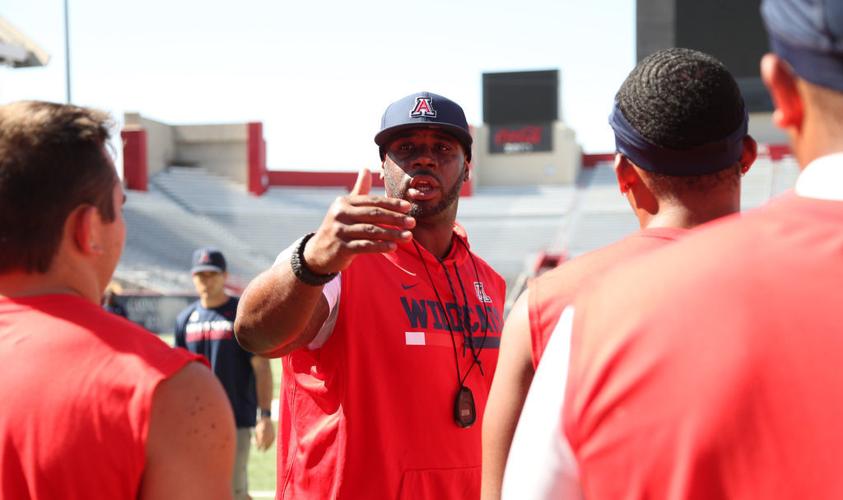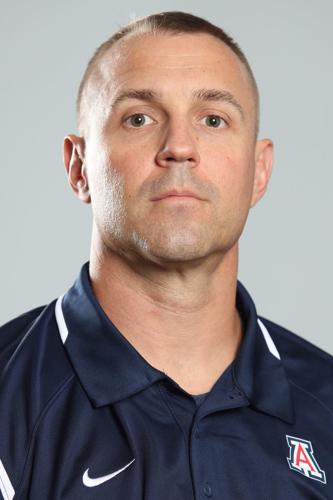Brian Johnson is playing a game of tag at a time when people are supposed to stay at least 6 feet apart from one another.
In his Instagram stories, the Arizona Wildcats’ director of strength and conditioning for football posts workout videos and tips — and “tagging” players and fellow coaches. He’s using peer pressure to navigate uncharted territory: how to keep 100-plus football players in shape while most of them don’t have access to a weight room.
Everyone is facing challenges and changes because of the coronavirus pandemic. Johnson and his fellow strength coaches have a distinct predicament: Under normal circumstances, they’re the most hands-on coaches on campus. So how do they do their jobs when they can’t go anywhere near the athletes they’re supposed to be training?
Johnson turned to Instagram and Twitter. “This generation,” he noted, “it’s all about social media.”
Johnson started tagging players in his IG Story posts, and the players started tagging one another.
“It’s just another culture-building piece,” Johnson said. “They’re challenging each other with pushups, they’re doing bench press, whatever resources they have. If they’re running out on a field, they’re tagging Coach (Kevin) Sumlin, they’re tagging myself, they’re tagging other teammates, and they’re saying, ‘Hey, where are you? I haven’t seen you working out today.’ ”
Jim Krumpos also is embracing technology during this peculiar time. Arizona’s associate athletic director of sports performance — who works with the Wildcats’ baseball, diving, soccer and volleyball programs — has been conducting Zoom meetings with other strength coaches, trainers and nutritionists. They’ve spent recent days determining the resources each athlete has available at home — then tailoring hundreds of individual workout regimens.
Additionally, Krumpos has made liberal use of BridgeAthletic’s BridgeTracker app, which provides athletes with sport-specific programs and enables them to log their training data.
The technology to train athletes remotely is better than it’s ever been. But it has its limits.
“Everything right now is totally voluntary,” Krumpos said. “We just have to rely on them more than anything. Even though they might be checking the box on the platform, that doesn’t necessarily mean that they’re doing it.”
The present situation — strongly recommended social distancing; closed campuses; limited, if any, access to gyms — has created new challenges for strength-and-conditioning staffs across the country. How do you help athletes maintain muscle mass if they can’t lift weights? How do you keep them focused and motivated? How do you make sure they’re doing what they’re supposed to do?
Meeting everyone’s needs
It’s 10:15 a.m. on Friday, and Johnson and Krumpos are speaking to a reporter. Johnson is in his garage. Krumpos is in his guest bedroom, which has become his home office. Everyone is communicating via Zoom video conferencing. Such is the world at the moment.
Johnson and Krumpos don’t have all the answers. They’re learning as they go, like all of us, and altering plans as needed. But they have a job to do, and they’re coming up with innovative ways to do it.
Everything has come at them in waves — different stages, ever evolving. When the crisis first began to escalate about 2½ weeks ago, the UA’s weight rooms were still open. Johnson and Krumpos spent several days figuring out safety protocols.
“And then,” Krumpos said, “literally as we were starting to implement that plan, it went to, now we’re not going to train; now everybody go home.”
“Our messaging to the athletes is changing week to week,” he added. “One thing I’m trying to wrap my mind around is to make sure that we are allowing them to deal with the situation, but also stay physically prepared.”
As athletes scattered about the country, the focus shifted to making sure they got home safely. Once they were situated, the strength coaches offered simple but needed support: “We’re here for you. We’re going to provide stuff to you.”
Then came figuring out what the athletes have access to and what they don’t. Quarterback Grant Gunnell’s family has a home gym setup. Defensive end JB Brown’s family — which includes older brother Jayon, a linebacker for the Tennessee Titans — has a VertiMax Platform. The VertiMax V8 lists for $3,495.
Others don’t even have dumbbells. Krumpos said most of the members of the diving team currently don’t have access to a pool.
“We have some athletes that are sitting in a room,” he said. “They aren’t allowed to leave their apartment.
“Some … still have access to full gym equipment, or they may have a gym at their house. So how do you meet the needs of all those different athletes?”
The coaches and their staffs reached out to every athlete to take inventory. They devised three basic workout structures: One that’s movement-and-body-weight-based for athletes who don’t have any equipment; one for those who have limited equipment such as dumbbells or a medicine ball; and one for those who still have access to full gyms.
“But that number is declining rapidly,” Krumpos said. “Even this week, I’ve had athletes say, ‘I still have access to a gym.’ The next day they text me, ‘I don’t have access to a gym anymore; (we) need to change this.’ ”
The situation has forced coaches and athletes to become creative. The Twitter feeds of special-teams coach Jeremy Springer and assistant strength coach Dylan Furrier are filled with backyard videos showing exercises that can be done with bricks, chairs, coolers and other items that can be found around the house.
“I have an assistant (Furrier) who’s on social media doing workouts with a loaded duffel bag and a backpack that we’re blasting so the players can see those things,” Johnson said. “Each coach has programmed a different workout.”
Rediscovering a routine
Keeping a consistent home workout schedule requires discipline many of us don’t have. Raise your hand if you’ve had a treadmill or exercise bike that eventually turned into a convenient place to hang your clothes.
The vast majority of Division I athletes are highly motivated and competitive; they wouldn’t be where they are otherwise. But the pandemic has thrown their world out of whack. It has disrupted the daily routines they have relied upon for years to help manage their myriad responsibilities.
“The athletes are struggling with the routine part of it, like we all are,” Krumpos said. “What’s the new normal? What’s the purpose? Why am I training right now?
“These athletes are used to having everything dictated them. This is when your class is going to be, this when your study hall is going to be, this is your tutoring, this is your film session, this is your practice, this is your lifting. And now there’s none of it.
“That seems to be the biggest obstacle. So … that’s really a message across the board right now: You make it easy on yourself by getting into a routine.”
Johnson and Krumpos have been urging athletes to follow a schedule that includes regular meals, workouts, schoolwork (all of which is being done online) and communication with coaches. It’s a slightly easier task for the football team, which didn’t have its season disrupted. The team lost about three-fourths of spring practice, but even during spring ball the squad is in offseason training mode. Johnson and the other football coaches constantly harp on proper nutrition, hydration and sleep.
“That’s what we preach every day,” Johnson said. “I’m a big routine guy. I think that’s just what performance is, period. My time as a professional athlete and dealing with professional athletes, some of the guys who last the longest are the ones who have routines, who stick to those routines; they know what works for them.”
As everyone settles into their new routines, the emphasis can shift more toward performance. The coaches can start delivering what Krumpos calls the “be-ready message.” No one knows when the pandemic will dissipate and society will return to normal, and that can be unnerving. But Johnson and Krumpos are determined to make sure their athletes are prepared when that day comes.
“Whoever takes advantage of this time the most right now is going to come out the best when this thing does clear,” Krumpos said. “The kids that haven’t done anything, that don’t do anything for whatever this is, weeks or months, man, they’re gonna be in a much different boat than the kids who continue to train.”




